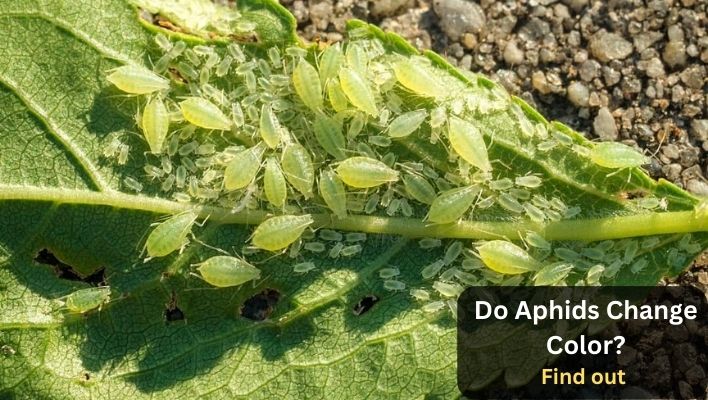Do aphids change colour? Have you ever wondered if aphids, those tiny insects that mysteriously appear on your plants, can change color? It turns out that these minuscule creatures are not just garden nuisances; they possess a remarkable talent for blending into their environment through a captivating variety of hues.
In this blog post, we will explore the intriguing question: Do aphids change color? Aphids, like nature’s own chameleons, exhibit an astonishing array of colors, ranging from green and brown to yellow, pink, chalk white, and even black. But why do they display such vibrant shades, and what purpose does their coloration serve?
We will delve into the secrets behind these miniature marvels and unravel the evolutionary significance of their ability to change color. Prepare to be amazed by the camouflage strategies, survival tactics, and fascinating adaptations that make aphids true masters of disguise.
Get ready to embark on a journey into the mesmerizing world of aphids, where colors hold secrets and nature’s hidden wonders are waiting to be discovered.
Aphids and their Characteristics
Before we delve into the fascinating world of aphid color change, let’s take a moment to understand these remarkable insects. Aphids are small, soft-bodied insects that measure only a few millimeters in length.
They come in a wide variety of colors, ranging from green and yellow to brown and even pink. These tiny insects have piercing-sucking mouthparts that they use to extract sap from plants.
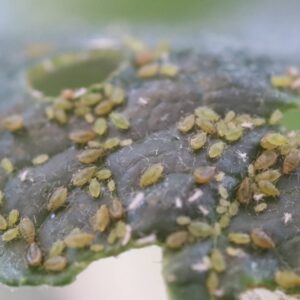
Aphids reproduce rapidly, with females giving birth to live offspring without the need for mating. This ability allows aphid populations to multiply quickly, making them a common sight in gardens, agricultural fields, and even indoor plants.
However, it’s not just their population growth that makes aphids intriguing; it’s their ability to change color that truly captivates our attention. If you sight aphids in your garden, then you get rid of them to prevent damage to your plants.
Factors Affecting Aphid Coloration
Aphids, those small and enigmatic insects, have a knack for blending seamlessly into their surroundings through their remarkable coloration.
The colors they exhibit are not merely coincidental but are influenced by a variety of factors. Let’s take a closer look at the key elements that shape the captivating hues of these tiny creatures.
- Environmental Factors: Aphids are masters of adaptation, and their color change is strongly influenced by the environment they inhabit. As the seasons shift, so do the colors of these remarkable insects. In spring and summer, when plants are lush and green, aphids often adopt vibrant shades of green to camouflage themselves among the leaves. In contrast, during autumn and winter, when foliage fades, aphids may transition to earthy browns or grays to remain inconspicuous amidst the changing landscape.
- Seasonal Changes: The cyclical nature of seasons plays a significant role in aphid coloration. These insects possess an innate ability to adjust their hues to match the prevailing environmental conditions. By seamlessly transitioning from one color to another, aphids ensure their survival by avoiding the prying eyes of predators.
- Predation and Defense Mechanisms: The ever-present threat of predators has shaped the evolution of aphid coloration. By altering their hues, aphids can effectively blend in with their plant hosts, making it harder for visual predators to detect them. Whether it’s ladybugs, lacewings, or birds, aphids have honed their color-changing abilities to reduce the risk of becoming a tasty meal.
Intriguingly, aphid coloration isn’t just a matter of chance; it’s a clever adaptation to their surroundings. The interplay of environmental factors, seasonal changes, and the ever-present pressure of predation has endowed these tiny insects with the power to transform, ensuring their survival in a vibrant and dynamic natural world
Types of Aphid Coloration
Aphids, those tiny and intriguing insects, come in a stunning array of colors. From vibrant greens to delicate pinks and even earthy browns, their hues span a spectrum that rivals nature’s palette.
Let’s delve into the various types of coloration seen in aphids and unravel the significance of their captivating shades for their survival.
Common Colors Observed in Aphids:
Green Aphids: The most frequently encountered color in aphids is undoubtedly green. Many species of aphids sport vibrant shades of green, ranging from pale lime to deep emerald. This coloration allows them to effortlessly blend in with the lush foliage of their host plants, providing a cloak of invisibility from prying eyes.
Yellow Aphids: In addition to green, aphids can also be seen in shades of yellow. These sunny hues serve a similar purpose, helping the insects camouflage themselves amidst yellowing leaves or flowers. By matching the color of their surroundings, aphids gain an advantage in evading detection.
Orange: Aphids with orange coloration can be found on host plants with orange or citrus-colored fruits, flowers, or leaves. This mimicry helps them blend in with their surroundings.
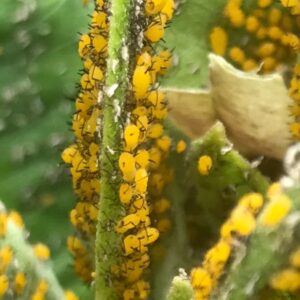
Brown Aphids: Some species of aphids adopt earthy tones, such as various shades of brown. This coloration enables them to merge seamlessly with the bark of trees or dried plant matter, providing effective camouflage against both predators and the watchful eyes of humans.
Pink Aphids: In certain instances, aphids exhibit beautiful shades of pink. These rosy hues often appear when aphids infest certain types of flowers. While the exact reasons behind this coloration are still being studied, it is believed to be a result of specific pigments present in their bodies.

Gray: Some aphids exhibit gray coloration, which allows them to blend with host plants that have gray or silver-colored leaves or stems. This camouflage helps them avoid detection by predators.
Striped or Patterned: Rather than a specific color, some aphids have striped or patterned coloration. These patterns can mimic the veining or markings on leaves, providing effective camouflage.
Red: Red aphids are less common but can be found on certain plant species. Their bright coloration serves as a warning signal to predators, indicating that they are toxic or unpalatable. This form of coloration, known as aposematism, deters predators from attacking them.

Black: Some aphids possess black coloration, which can offer protection from predators by allowing them to blend in with dark backgrounds or shadows. This coloration also aids in absorbing heat from sunlight, enabling aphids to raise their body temperature in cooler environments.
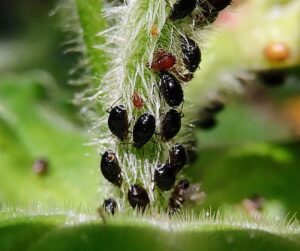
White: White or pale-colored aphids are often associated with specific host plants, such as cabbage or milkweed. Their coloration may help them avoid predation by blending in with the plant’s light-colored tissues or hairs.
Importance of Coloration for Aphid Survival:
Coloration is more than just an aesthetic trait for aphids; it plays a vital role in their survival. The ability to change and match their colors to their surroundings grants aphids a significant advantage in evading predators.
By blending in seamlessly with the foliage or bark, these tiny insects increase their chances of remaining undetected and escaping the jaws of hungry predators.
Additionally, coloration also aids aphids in the selection of suitable host plants. Certain species of aphids exhibit preferences for specific plants, and their coloration may serve as a signal to potential mates or indicate their preferred food sources.
The diverse range of colors observed in aphids is a testament to the incredible adaptability and evolutionary strategies employed by these remarkable insects. Their ability to transform their hues ensures their survival in a world where detection can mean the difference between life and death.
Reasons Behind Aphid Color Change
The ability of aphids to change their coloration is a mesmerizing phenomenon. But what drives this remarkable transformation?
Let’s delve into the intricate reasons behind aphid color change and explore the factors that shape their chameleon-like abilities.
- Physiological Factors: Physiological changes within aphids can trigger shifts in their coloration. Hormonal fluctuations play a significant role in regulating pigmentation, causing aphids to exhibit different hues. As their internal mechanisms adjust, these tiny insects can swiftly adapt their color to match their environment or respond to immediate threats. It’s a remarkable example of nature’s ability to swiftly modify appearances for survival.
- Genetic Factors: Genetics also influence aphid coloration. Some aphid species possess genes that allow them to produce various pigments, leading to a wide range of color variations. These genetic differences contribute to the diversity of color observed within aphid populations. Such genetic variability allows them to adapt to different environments and host plants, increasing their chances of survival and successful reproduction.
- Adaptation to Host Plants: Aphids are intimately tied to their host plants. They rely on these plants for food and shelter. Consequently, their coloration can adapt to match the foliage of specific host plants. By adjusting their hues to blend seamlessly with the leaves, stems, or flowers, aphids gain a valuable advantage: they become virtually invisible to predators. This adaptation increases their chances of survival by reducing the risk of being detected and consumed.
- Camouflage and Predation Avoidance: Color change in aphids serves as a crucial strategy for camouflage and predation avoidance. By altering their hues, aphids can match the colors of their immediate surroundings, making them extremely difficult to spot. This camouflage helps them evade the watchful eyes of predators that rely on visual cues to locate their prey. The ability to blend in effectively increases their chances of survival and successful reproduction, ensuring the perpetuation of their species.
Through physiological changes, genetic diversity, adaptation to host plants, and the art of camouflage, aphids have mastered the art of color change. Their remarkable ability to transform their appearance enables them to thrive in a world filled with potential threats.
Case Studies and Interesting Examples
The world of aphid color change is filled with captivating case studies and intriguing species-specific examples. Let’s explore some notable studies and examples that shed light on the captivating colors exhibited by these tiny insects.
Notable Studies on Aphid Color Change:
Researchers have delved into the mechanisms behind aphid color change, uncovering fascinating insights. In a study published in the journal Nature Communications, scientists discovered that aphids possess specialized cells called “color cells” that can rapidly change their pigmentation.
This cellular flexibility allows aphids to adjust their coloration in response to environmental cues, offering a glimpse into the intricate cellular processes that underlie their chameleon-like abilities.
Another study, conducted by scientists at the University of California, Berkeley, focused on the influence of temperature on aphid color change.
The researchers found that temperature fluctuations affect the expression of certain genes responsible for pigmentation. This discovery highlighted the importance of environmental factors in shaping the colorful world of aphids.
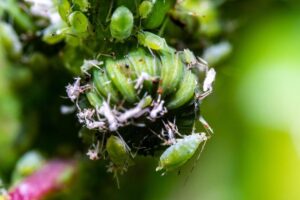
Species-Specific Examples of Color Variation:
Aphid coloration is not limited to a single pattern or palette. Different species exhibit unique color variations that have evolved to suit their specific habitats and host plants.
For instance, the green peach aphid (Myzus persicae) is aptly named for its vibrant green coloration, allowing it to blend effortlessly with the foliage of its preferred host plants, such as peach and other fruit trees.
On the other hand, the woolly aphid (Eriosomatinae) possesses a distinct white or wool-like appearance, which helps it camouflage among the waxy secretions it produces on trees. This adaptation protects them from predators and environmental conditions.
Species-specific color variations illustrate the remarkable adaptability of aphids, showcasing how their hues have evolved to maximize survival in diverse ecological niches.
These case studies and species-specific examples provide a glimpse into the intricate world of aphid coloration. They underscore the importance of scientific research in unraveling the mysteries of these tiny insects and shedding light on the mechanisms behind their captivating transformations.
Do Aphids Change Colour FAQ?
Can aphids change color rapidly?
Yes, aphids have the remarkable ability to change color relatively quickly. The speed of their color change can vary depending on several factors, including environmental conditions and physiological responses.
In some cases, aphids can undergo color change within a few hours or days. This rapid adaptation allows them to respond swiftly to changes in their environment, such as shifting seasons or immediate threats from predators.
Aphids’ ability to change color rapidly is a vital survival strategy that enhances their chances of blending in with their surroundings and avoiding predation.

Do all aphids change color?
While color change is a common phenomenon among aphids, not all species exhibit the same degree of color variation. Some aphid species remain relatively constant in color throughout their life cycle, while others show a more pronounced ability to change hues.
The extent of color change can also vary within a species, influenced by factors such as genetics and environmental conditions. It’s important to note that while color change is widespread among aphids, the specific patterns and mechanisms can differ among different species and populations.
How do aphids benefit from color change?
Aphids benefit from color change in several ways. First and foremost, the color change allows them to blend in with their environment, providing a camouflage that helps them evade detection by predators.
By matching the colors of their host plants or the surrounding foliage, aphids become less conspicuous and increase their chances of survival. Additionally, the color change enables aphids to adapt to different host plants.
By adjusting their hues to match the specific plant they feed on, aphids can improve their chances of finding suitable food sources and increase their overall fitness.
Are aphid color changes reversible?
Yes, in some cases, aphid color changes can be reversible. The reversibility of color change in aphids depends on various factors, including the species, environmental conditions, and the specific mechanism driving the coloration.
In some instances, aphids can adjust their coloration back to their original state when the environmental conditions or threats that triggered the change are no longer present.
However, the exact mechanisms and conditions for color reversibility in aphids are still being studied, and they may vary among different species and populations.
Conclusion
In this exploration of aphid color change, we have uncovered the intriguing world of these tiny insects and their remarkable ability to adapt their hues. Let’s recap the main points discussed and emphasize the importance of understanding aphid color change.
Aphids, those small insects that feed on plant sap, possess the remarkable capacity to change their coloration. This adaptation is influenced by various factors, including environmental conditions, genetic diversity, and physiological responses. By adjusting their hues, aphids can seamlessly blend with their surroundings, enhancing their chances of survival.
Understanding aphid color change is vital for appreciating the intricate adaptations of these insects. By comprehending the interplay between their environment, genetics, and coloration, we gain insight into the strategies they employ to survive in a world filled with potential predators.
In conclusion, the study of aphid color change unravels a world of beauty and adaptability. As we continue to explore the mysteries of these tiny insects, let us appreciate their ability to transform and adapt, and let us strive to protect the delicate balance of nature that sustains them.
